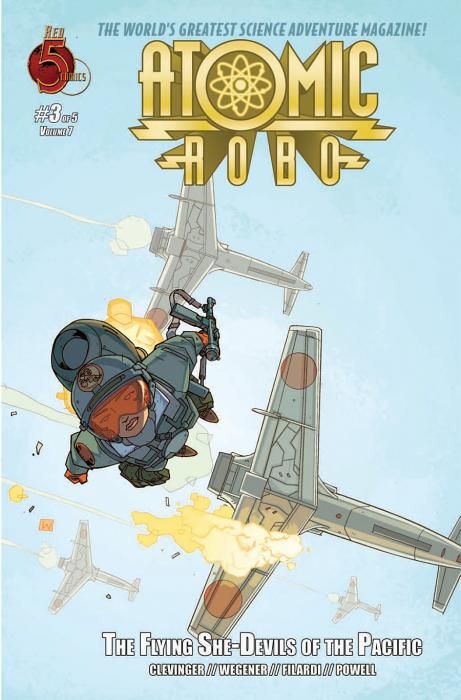Like many readers, I was unaware of "Atomic Robo" until it was nominated for multiple Eisner awards and I realized that writer Brian Clevinger was the same guy who wrote the hilarious "8-bit Theater" webcomic. I should have picked it up earlier. "Atomic Robo and the Flying She-Devils of the Pacific" is an excellent story arc midpoint. Like preceding issues, it's a deft interweaving of fantasy with real historical events, and the artwork by Scott Wegener and Nick Filardi is gorgeous.
Wegener's style is cartoony and light-hearted, but his panels also have a sense of deep, expansive space and atmosphere due to his minimalist and harmonious compositions. His facial expressions and body language are spot on. Robo's circular headlight-like eyes are usually unmoving and observant, but Wegener can make them emote like crazy at the right moments. A single raised lower eyelid radiates low-key disbelief and wariness mid-issue, and Robo goes through an emotional wringer on the ominous last page, his eyes and posture flashing through surprise, bitterness, irony, aggression, defiance, rage, skepticism and settling into resignation and sadness.
The intense colors laid down in flat swathes by Nick Filardi carry the mood and atmosphere of the comic. Former colorist Ronda Pattison got an Eisner nomination for her work on previous "Atomic Robo" series. Filardi is an excellent successor and deserves as much recognition. He neatly divides the issue into a contrast between land and sea, with interiors and people in warm tones and the action over open sky and sea in cold tones.
The night sky changes across the issue, variously midnight blue, teal and violet but always speckled like an egg with flecks of white. One lemon-lime panel visually separates an explosion from the rest of the issue. The thin-lined, flower-like glare patterns of two spaceship headlights look eerie and threatening in translucent acid turquoise against a purplish desert night. Over Wegener's deft compositions, Filardi pulls off unusual, daring coloring choices. Planes arc in wine-dark spiral trails, tumbling across an indigo sky and cerulean sea. Gunfire follows the trajectory of Robo's body in light lemon yellow arcing splotches.
"Atomic Robo and the Flying She-Devils of the Pacific" #3 is worth looking at just for the art, but the story so far is strong as well. This mid-point issue is light on plot advancement until the last couple of pages, but the decompressed storytelling leaves all the space for visual fireworks, so I'm not complaining. Like Wegener's art, Clevinger mixes heavy and light seemingly effortlessly and the story and characters feel both fun and substantial.
Each successive limited series of "Atomic Robo" centers around a cohesive theme, and "Atomic Robo and the Flying She-Devils of the Pacific" is an action/aviation/war adventure in the post-WWII Pacific Theatre. The feisty, bossy titular Flying She-Devils who rescue Robo make an excellent foil to his calm and wise-cracking reserve. Issue #3 illuminates a different side of Robo's personality as the reader watches him feel like a useless third wheel and get himself into some more trouble.
If you haven't been picking "Atomic Robo" up, it's definitely worth jumping on this Flying She-Devils story arc or any of the previous six collected miniseries. Each series is standalone and dense with world-building and story, yet they all feel approachable to a newcomer. Fans of "Hellboy" or "Planetary" in particular should try it if they're not already reading it.

